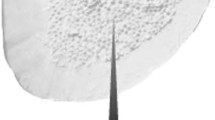Abstract
Synthetic bone-graft substitutes are increasingly being used in clinical orthopaedic practice. In India, Sree Chitra Tirunal Institute of Medical Sciences and Technology has pioneered the research and development of indigenous ceramic bone substitutes. The Chitra HAP is a synthetic porous Hydroxyapatite that has completed pre-market trials according to prescribed format and has also undergone limited clinical trials in humans. This study is a clinical trial to ascertain the use of the product in the treatment of cancellous impaction fractures. Twenty-eight tibial plateau fractures were treated by a standard surgical protocol using the HAP for cancellous bone augmentation. The results were evaluated by serial radiography at specified intervals up to 1 year. At 1 year the HAP appeared fully integrated with the host bone radiologically and the articular subsidence had ceased. The synthetic HAP remained radio-opaque even at 1 year. No adverse effects were noticed due to the synthetic material. It was concluded that Chitra porous HAP is a safe and useful bone graft substitute for cancellous bone augmentation in fractures.
Résumé
Les substituts osseux sont de plus en plus employés dans la pratique orthopédique ou traumatologique. L’Institut des Sciences et de la Technologie Médicales de Sree Chitra Thirunal (Inde) a initié la recherche et le développement d’un substitut osseux. Le Chitra-HAP est une hydroxyapatite poreuse synthétique qui a satisfait aux épreuves de pré-market selon les normes définies et a également été utilisé dans des essais cliniques limités chez l’homme. Cette étude a pour objet de valider l’utilisation du produit dans le traitement des fractures du plateau tibial externe avec tassement. Vingt huit fractures ont été traitées selon un protocole chirurgical standard en utilisant le Chitra-HAP pour combler la perte d’os spongieux. Les résultats ont été évalués par radiographie à intervalles réguliers jusqu’à 1 an. A un an, le Chitra-HAP semble radiologiquement entièrement intégré à l’os hôte et on n’observe pas d’enfoncement articulaire. Le Chitra-HAP synthétique reste radio-opaque même à un an. Aucun effet secondaire n’a été relevé. On peut conclure que le Chitra-HAP est un substitut de remplacement sûr et efficace pour combler les pertes de substance d’os spongieux dans les fractures du plateau tibial externe.









Similar content being viewed by others
References
Bucholz RW, Carlton A, Holmes R (1989) Interporous Hydroxyapatite as bone graft substitute in tibial plateau fractures. Clin Orthop 240:53–62
Chapman MW, Bucholz R, Cornell C (1997) Treatment of Acute fractures with a collagen-calcium phosphate graft material: a randomized clinical trial. J Bone Joint Surg 79-A:495–501
Horstmann WG, Verheyen CC, Leemans R (2003) An injectable calcium phosphate cement as a bone-graft substitute in the treatment of displaced lateral tibial plateau fractures. Injury Feb 34(2):141–144
Khodadadyan-Klostermann C, Liebig T, Melcher I, Raschke M, Haas NP (2002) Osseous integration of hydroxyapatite grafts in metaphyseal bone defects of the proximal tibia (CT-study). Acta Chir Orthop Traumatol Cech 69(1):16–21
Ladd AL, Pliam NB (1999) Use of bone graft substitutes in Distal Radius fractures. J Am Acad Orthop Surg 7(5):279–290
LeGeros RZ, LeGeros JP (1993) Dense Hydroxyapatite. In: Hench LL, Wilson J (eds) An introduction to Bioceramics. World Scientific, Delhi, pp 139–180
Lobenhoffer P, Gerich T, Witte F, Tscherne H (2002) Use of an injectable calcium phosphate bone cement in the treatment of tibial plateau fractures: a prospective study of twenty-six cases with twenty-month mean follow-up. J Orthop Trauma 16(3):143–149
Manoj K, Varma HK, Sivakumar R (2000) On the development of an apatite phosphate bone cement. Bull Mater Sci 23(2):135–145
Menon KV (2002) Clinical Trial of Chitra Hydroxyapatite Porous Granules: Ethics Committee approved clinical trial report submitted to the Sree Chitra Thirunal Institute of Medical Sciences and Technology, Kerala, India
Rasmussen PS (1973) Tibial condylar fractures: impairment of knee joint function as an indication for surgical treatment. J Bone Joint Surg Am 55:1331–1350
Ravglioli A, Krajewski A (1992) Bioceramics: material properties, applications. Chapman and Hall, Madras
Samsheer KM (2000) Comparative evaluation of Chitra HA granule and Ossopan-Chitosan Sol in the management of periodontal intra bony defects: a clinical study. MDS Dissertation thesis, University of Kerala
Scaglione PH, Buchman MT (1997) Collagraft bone substitute in upper extremity fractures: a preliminary study. Surg Forum 48:563–565
Schatzker J (2000) Fractures of the Tibial Plateau. In: Schatzker J, Tile M (eds) The rationale of operative fracture care. Springer, Berlin Heidelberg New York, pp 419–437
Shors EC, Holmes RE (1993) Porous Hydroxyapatite. In: Hench LL, Wilson J (eds) An introduction to Bioceramics. World Scientific, Delhi, pp 181–198
Sunny MC, Ramesh P, Varma HK (2002) Microstructured microspheres of hydroxyapatite bioceramic. J Mater Sci Mater Med 13:1–10
Towler M, Varma HK, Best SM, Bonfield W (1996) Processing and mechanical testing of hydroxyapatite/zirconium oxide composite for load bearing applications. In: Proceedings of the Fifth World Biomaterials Congress, Toronto
Urban K (2002) Use of bioactive glass ceramics in the treatment of tibial plateau fractures. Acta Chir Orthop Traumatol Cech 69(5):295–301 (Abstract only)
Varma HK, Sivakumar R (1996) Preparation and characterisation of free flowing Hydroxy apatite powders. Phosphorous Res Bull 6:35–38
Velayudhan S, Varma HK, Ramesh P (2000) Extrusion of hydroxyaptite into clinically significant shapes. Mater Lett 46:142–146
Velayudhan S, Ramesh P, Varma HK (2001) Hydroxyapatite filled EVA copolymer composite for bone substitute applications. Trends Biomater Art Org 14:21–23
Vijayan S, Varma HK (2002) Microwave sintering of nanosized Hydroxyapatite powder compact. Mater Lett 56(5):827–831
YamamuroT, Hench LL (1990) In: Wilson J (ed) Handbook of bioactive ceramics. CRC, Boca Raton
Yetkinler DN, Ladd AL, Poser RD, Constanz BR, Carter D (1999) Biomechanical evaluation of fixation of intra-articular fractures of the distal part of the Radius in cadavera: Kirschner wires compared with calcium-phosphate bone cement. J Bone Joint Surg Am 81:391–399
Younger EM, Chapman MW (1989) Morbidity at bone graft donor sites. J Orthop Trauma 3:192–195
Author information
Authors and Affiliations
Corresponding author
Rights and permissions
About this article
Cite this article
Menon, K.V., Varma, H.K. Radiological outcome of tibial plateau fractures treated with percutaneously introduced synthetic porous Hydroxyapatite granules. Eur J Orthop Surg Traumatol 15, 205–213 (2005). https://doi.org/10.1007/s00590-005-0238-6
Received:
Accepted:
Published:
Issue Date:
DOI: https://doi.org/10.1007/s00590-005-0238-6




